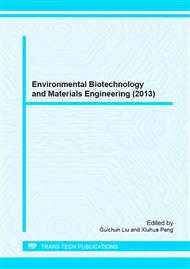p.314
p.318
p.326
p.330
p.337
p.341
p.347
p.352
p.356
Variation of Disinfection By-Products Formation Potential Species at Several Stages of Drinking Water Treatment Plants
Abstract:
The variation of disinfection by-products (DBPs) at several stages of drinking water treatment plants was investigated in two drinking water plants. The results clearly indicate that the low molecular weight total organic carbon (TOC) which has been identified as primary precursor for chlorinated DBPs was difficult to remove by coagulation. Plant A which used conventional coagulation/sedimentation could not decrease the species of trihalomethanes (THMs) and haloacetic acids (HAAs) formation potential. Biological activated carbon (BAC) was applied in Plant B which removed the maximum amount of TOC, while more kinds of microbial products were produced in BAC unit which could be the potential precursors of DBPs. Therefore, the species of DBPs formation potential still increased in the treatment processes of Plant B. Because different components of organic precursors produced different DBPs species, the processes of Plant B could decrease TOC efficiently but the species of THMs and HAAs formation potential.
Info:
Periodical:
Pages:
337-340
Citation:
Online since:
September 2013
Authors:
Price:
Сopyright:
© 2013 Trans Tech Publications Ltd. All Rights Reserved
Share:
Citation:


